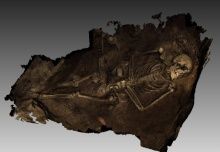3D Scanning Fallen Soldiers in Russia – Immortalization of the Battle of Borodino

Even though most recent news on 3D scanning has been about prosumer-targeted desktop solutions, the majority of which are currently still lying on the design tables with a sole focus on winning the price-race to the bottom, in the professional field the attributes making up for a useful product are compiled very differently. In disciplines like archeology, where the field work is a core part of the job description in the everlasting quest to discover new relics and other artifacts in trying to better understand humanity’s history; portability and suitability for handheld usage are obviously important factors at excavation sites old and new.
Two hundred years ago saw the battle of Borodino between the defending Russian army and the invading troops led by Napoleon. The fight was crucial – Borodino was the last line of defense standing between the French soldiers and the capital city, with the number of participating troops certainly reflecting that relevance – estimated at more than 250,000 men taking part in the battle, with over a quarter of them not returning home alive. Even though tragic – as a war situation always is – this massive death site has been a valuable source of knowledge for archaeologists and others interested in what lies beneath the surface. One of the latest efforts in this sector was organized by the Russian Academy of Sciences and their Institute of Archeology with an intent to better map out – and scan – the discovered (rather gruesome) remains of the fallen soldiers and their equine companions.
On the technological side, the Academy partnered up with Artec, a company specializing in pro-grade 3D scanning solutions – at least for designers and institutions not shy of spending $10k+ on their scanning hardware.
For this purpose the team used Artec’s MHT scanner, which enables 24 bpp results in up to 0.5mm resolution/0.1 3D point accuracy – to scan every remains of bones and bits found in the excavation sites in the area. Using 3D scanning instead of the traditional archaeological weapon of choice – 2D photography – proved to be a superior choice, as the added dimension gave the field researchers much more accurate and further analyzable data of the found objects, and it was also possible to post-process this data in a fraction of the time that traditional data would have taken.

As the technology evolves even further, innovative solutions such as the one used by the Russian Institute of Archeology are bound to shed more light on many mysteries that the past still holds. This approach can also serve as a basis – to enable leaving the remains – in this case humans and horses – to rest in their shallow graves but also immortalized physically, if 3D printing was also to be used to finish the project before bringing the results before the eyes of the general public. Whether or not the Russian archaeologists plan to do this or not is unknown, but we’re definitely going to see this paradigm being put into practice more and more in the future.







